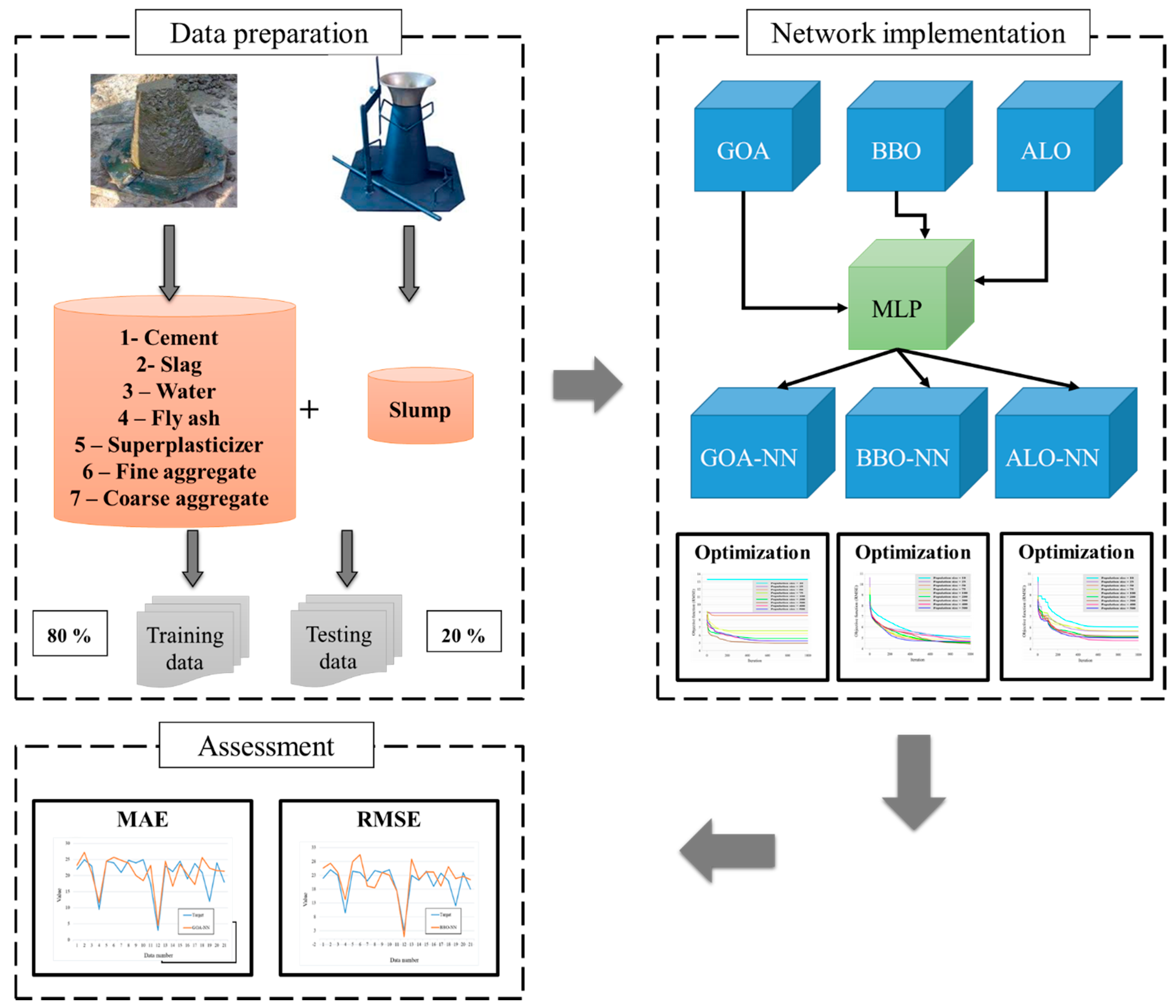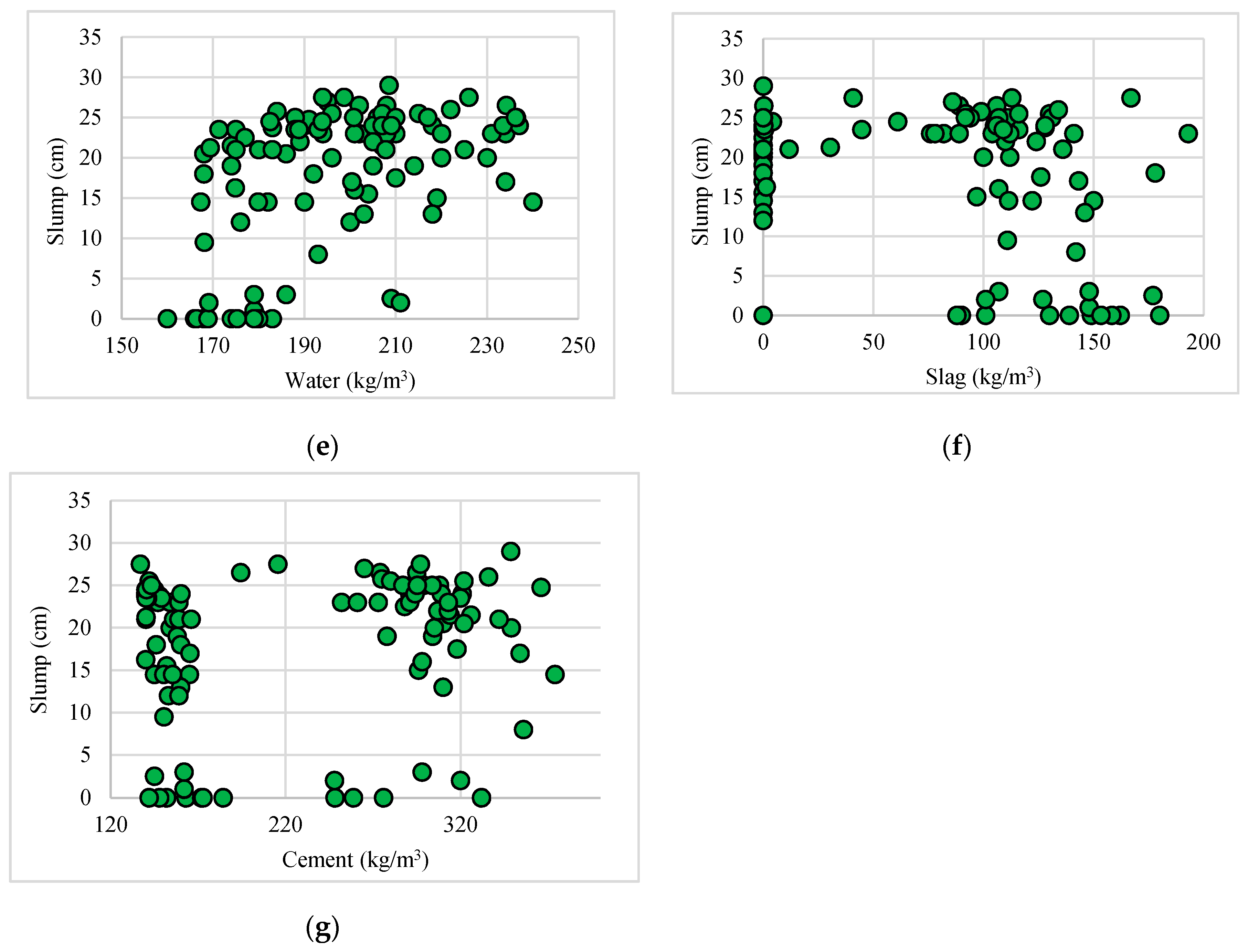Application of Three Metaheuristic Techniques in Simulation of Concrete Slump
Abstract
:1. Introduction
2. Methodology
2.1. Ant Lion Optimization
2.2. Benchmark Models
3. Data Collection and Statistical Analysis
4. Results and Discussion
4.1. ALO, BBO, and GOA Conventional Methods for Optimizing the NN
4.2. Performance Evaluation and Discussion
5. Conclusions
Author Contributions
Funding
Conflicts of Interest
References
- Henigal, A.; Elbeltgai, E.; Eldwiny, M.; Serry, M. Artificial Neural Network Model for Forecasting Concrete Compressive Strength And Slump In Egypt. J. Al Azhar Univ. Eng. Sect. 2016, 11, 435–446. [Google Scholar] [CrossRef]
- Yeh, I.-C. Modeling slump flow of concrete using second-order regressions and artificial neural networks. Cem. Concr. Compos. 2007, 29, 474–480. [Google Scholar] [CrossRef]
- Antiohos, S.; Papadakis, V.; Tsimas, S. Rice husk ash (RHA) effectiveness in cement and concrete as a function of reactive silica and fineness. Cem. Concr. Res. 2014, 61, 20–27. [Google Scholar] [CrossRef]
- McCulloch, W.S.; Pitts, W. A logical calculus of the ideas immanent in nervous activity. Bull. Math. Biophys. 1943, 5, 115–133. [Google Scholar] [CrossRef]
- Moayedi, H.; Abdullahi, M.a.M.; Nguyen, H.; Rashid, A.S.A. Comparison of dragonfly algorithm and Harris hawks optimization evolutionary data mining techniques for the assessment of bearing capacity of footings over two-layer foundation soils. Eng. Comput. 2019, 1–11. [Google Scholar] [CrossRef]
- Moayedi, H.; Armaghani, D.J. Optimizing an ANN model with ICA for estimating bearing capacity of driven pile in cohesionless soil. Eng. Comput. 2017, 1–10. [Google Scholar] [CrossRef]
- Moayedi, H.; Foong, L.K.; Nguyen, H.; Bui, D.T.; Jusoh, W.A.W.; Rashid, A.S.A. Optimizing ANN models with PSO for predicting in short building seismic response. Eng. Comput. 2019, 1–16. [Google Scholar] [CrossRef]
- Moayedi, H.; Mehdi, R.; Abolhasan, S.; Wan, A.W.J.; Safuan, A.R.A. Optimization of ANFIS with GA and PSO estimating α in driven shafts. Eng. Comput. 2019, 35, 1–12. [Google Scholar] [CrossRef]
- ASCE Task Committee. Artificial neural networks in hydrology. II: Hydrologic applications. J. Hydrol. Eng. 2000, 5, 124–137. [Google Scholar] [CrossRef]
- Moayedi, H.; Hayati, S. Modelling and optimization of ultimate bearing capacity of strip footing near a slope by soft computing methods. Appl. Soft Comput. 2018, 66, 208–219. [Google Scholar] [CrossRef]
- Moayedi, H.; Huat, B.B.; Mohammad Ali, T.A.; Asadi, A.; Moayedi, F.; Mokhberi, M. Preventing landslides in times of rainfall: Case study and FEM analyses. Disaster Prev. Manag. 2011, 20, 115–124. [Google Scholar] [CrossRef]
- Moayedi, H.; Hayati, S. Applicability of a CPT-Based Neural Network Solution in Predicting Load-Settlement Responses of Bored Pile. Int. J. Geomech. 2018, 18, 06018009. [Google Scholar] [CrossRef]
- Seyedashraf, O.; Mehrabi, M.; Akhtari, A.A. Novel approach for dam break flow modeling using computational intelligence. J. Hydrol. 2018, 559, 1028–1038. [Google Scholar] [CrossRef]
- Hecht-Nielsen, R. Theory of the backpropagation neural network. In Neural Networks for Perception; International 1989 Joint Conference on Neural Networks; IEEE: Washington, DC, USA, 1989; pp. 65–93. [Google Scholar] [CrossRef]
- Moayedi, H.; Moatamediyan, A.; Nguyen, H.; Bui, X.-N.; Bui, D.T.; Rashid, A.S.A. Prediction of ultimate bearing capacity through various novel evolutionary and neural network models. Eng. Comput. 2019, 35. [Google Scholar] [CrossRef]
- Moayedi, H.; Mosallanezhad, M.; Mehrabi, M.; Safuan, A.R.A.; Biswajeet, P. Modification of landslide susceptibility mapping using optimized PSO-ANN technique. Eng. Comput. 2019, 35, 967–984. [Google Scholar] [CrossRef]
- Aksoy, H.S.; Gör, M.; İnal, E. A new design chart for estimating friction angle between soil and pile materials. Geomechanics and Engineering 2016, 10, 315–324. [Google Scholar] [CrossRef]
- Nguyen, H.; Moayedi, H.; Sharifi, A.; Amizah, W.J.W.; Safuan, A.R.A. Proposing a novel predictive technique using M5Rules-PSO model estimating cooling load in energy-efficient building system. Eng. Comput. 2019, 35, 1–11. [Google Scholar] [CrossRef]
- Vakhshouri, B.; Nejadi, S. Prediction of compressive strength of self-compacting concrete by ANFIS models. Neurocomputing 2018, 280, 13–22. [Google Scholar] [CrossRef]
- Bilgehan, M.; Kurtoglu, A.E. ANFIS-based prediction of moment capacity of reinforced concrete slabs exposed to fire. Neural Comput. Appl. 2016, 27, 869–881. [Google Scholar] [CrossRef]
- Juncai, X.; Qingwen, R.; Zhenzhong, S. Prediction of the strength of concrete radiation shielding based on LS-SVM. Ann. Nucl. Energy 2015, 85, 296–300. [Google Scholar] [CrossRef]
- Li, X.; Yi, G.; Wang, W.; Sun, J.; Li, Y. Research and Application of RBF Neural Network-Based Osmotic Pressure Forecast Model for Concrete-Faced Rockfill Dam; IOP Publishing: Bristol, UK, 2018; Volume 198. [Google Scholar] [CrossRef]
- Oztaş, A.; Pala, M.; Ozbay Ea Kanca, E.; Caglar, N.; Bhatti, M.A. Predicting the compressive strength and slump of high strength concrete using neural network. Constr. Build. Mater. 2006, 20, 769–775. [Google Scholar] [CrossRef]
- Yeh, I.-C. Simulation of concrete slump using neural networks. Constr. Mater. 2009, 162, 11–18. [Google Scholar] [CrossRef]
- Yeh, I.-C. Exploring concrete slump model using artificial neural networks. J. Comput. Civ. Eng. 2006, 20, 217–221. [Google Scholar] [CrossRef]
- Gao, W.; Raftari, M.; Rashid, A.S.A.; Mu’azu, M.A.; Jusoh, W.A.W. A predictive model based on an optimized ANN combined with ICA for predicting the stability of slopes. Eng. Comput. 2019, 1–20. [Google Scholar] [CrossRef]
- Bui, D.T.; Moayedi, H.; Gör, M.; Jaafari, A.; Foong, L.K. Predicting slope stability failure through machine learning paradigms. ISPRS Int. Geo-Inf. 2019, 8, 395. [Google Scholar] [CrossRef]
- Yuan, C.; Moayedi, H. The performance of six neural-evolutionary classification techniques combined with multi-layer perception in two-layered cohesive slope stability analysis and failure recognition. Eng. Comput. 2019, 1–10. [Google Scholar] [CrossRef]
- Nguyen, H.; Mehrabi, M.; Kalantar, B.; Moayedi, H.; Abdullahi, M.A.M. Potential of hybrid evolutionary approaches for assessment of geo-hazard landslide susceptibility mapping. Geomat. Nat. Hazards Risk 2019, 10, 1667–1693. [Google Scholar] [CrossRef]
- Xu, J.; Shen, Z.; Ren, Q.; Xie, X.; Yang, Z. Geometric Semantic Genetic Programming Algorithm and Slump Prediction. arXiv 2017, arXiv:1709.06114. [Google Scholar]
- Chandwani, V.; Agrawal, V.; Nagar, R. Modeling slump of ready mix concrete using genetic algorithms assisted training of Artificial Neural Networks. Expert Syst. Appl. 2015, 42, 885–893. [Google Scholar] [CrossRef]
- Chen, L.; Kou, C.-H.; Ma, S.-W. Prediction of slump flow of high-performance concrete via parallel hyper-cubic gene-expression programming. Eng. Appl. Artif. Intell. 2014, 34, 66–74. [Google Scholar] [CrossRef]
- Mirjalili, S. The ant lion optimizer. Adv. Eng. Softw. 2015, 83, 80–98. [Google Scholar] [CrossRef]
- Spoljaric, T.; Pavic, I. Performance analysis of an ant lion optimizer in tuning generators’ excitation controls in multi machine power system. In Proceedings of the 2018, 41st International Convention on Information and Communication Technology, Electronics and Microelectronics (MIPRO), Opatija, Croatia, 21–25 May 2018. [Google Scholar]
- Simon, D. Biogeography-based optimization. IEEE Trans. Evolut. Comput. 2008, 12, 702–713. [Google Scholar] [CrossRef]
- Saremi, S.; Mirjalili, S.; Lewis, A. Grasshopper optimisation algorithm: Theory and application. Adv. Eng. Softw. 2017, 105, 30–47. [Google Scholar] [CrossRef]
- Moayedi, H.; Bui, D.T.; Gör, M.; Pradhan, B.; Jaafari, A. The feasibility of three prediction techniques of the artificial neural network, adaptive neuro-fuzzy inference system, and hybrid particle swarm optimization for assessing the safety factor of cohesive slopes. ISPRS Int. Geo-Inf. 2019, 8, 391. [Google Scholar] [CrossRef]
- Yuan, C.; Moayedi, H. Evaluation and comparison of the advanced metaheuristic and conventional machine learning methods for prediction of landslide occurrence. Eng. Comput. 2019, 36. [Google Scholar] [CrossRef]
- Mirjalili, S.; Mirjalili, S.M.; Lewis, A. Let a biogeography-based optimizer train your multi-layer perceptron. Inf. Sci. 2014, 269, 188–209. [Google Scholar] [CrossRef]
- Ma, H.; Simon, D. Blended biogeography-based optimization for constrained optimization. Eng. Appl. Artif. Intell. 2011, 24, 517–525. [Google Scholar] [CrossRef] [Green Version]
- Simon, D. A probabilistic analysis of a simplified biogeography-based optimization algorithm. Evolut. Comput. 2011, 19, 167–188. [Google Scholar] [CrossRef]
- Ma, H.; Simon, D. Analysis of migration models of biogeography-based optimization using Markov theory. Eng. Appl. Artif. Intell. 2011, 24, 1052–1060. [Google Scholar] [CrossRef] [Green Version]
- Mirjalili, S.Z.; Mirjalili, S.; Saremi, S.; Faris, H.; Aljarah, I. Grasshopper optimization algorithm for multi-objective optimization problems. Appl. Intell. 2018, 48, 805–820. [Google Scholar] [CrossRef]
- ASTMC 143. Standard Test Method for Slump of Hydraulic-Cement Concrete; ASTM International: West Conshohocken, PA, USA, 2005. [Google Scholar]
- Yeh, I.-C.; Chen, J.W. Modeling Workability of Concrete Using Design of Experiments and Artificial Neural Networks. J. Technol. 2005, 20, 153–162. [Google Scholar]
- Bui, D.T.; Abdullahi, M.a.M.; Ghareh, S.; Moayedi, H.; Nguyen, H. Fine-tuning of neural computing using whale optimization algorithm for predicting compressive strength of concrete. Eng. Comput. 2019, 1–12. [Google Scholar] [CrossRef]
- Nehdi, M.; El Chabib, H.; El Naggar, M.H. Predicting performance of self-compacting concrete mixtures using artificial neural networks. Mater. J. 2001, 98, 394–401. [Google Scholar]
- Gao, W.; Wang, W.; Dimitrov, D.; Wang, Y. Nano properties analysis via fourth multiplicative ABC indicator calculating. Arabian journal of chemistry 2018, 11, 793–801. [Google Scholar] [CrossRef]
- Gao, W.; Dimitrov, D.; Abdo, H. Tight independent set neighborhood union condition for fractional critical deleted graphs and ID deleted graphs. Discrete & Continuous Dynamical Systems-S 2018, 12, 711–721. [Google Scholar]
- Gao, W.; Guirao, J.L.G.; Abdel-Aty, M.; Xi, W. An independent set degree condition for fractional critical deleted graphs. Discrete & Continuous Dynamical Systems-S 2019, 12, 877–886. [Google Scholar] [Green Version]
- Gao, W.; Guirao, J.L.G.; Basavanagoud, B.; Wu, J. Partial multi-dividing ontology learning algorithm. Inf. Sci. 2018, 467, 35–58. [Google Scholar] [CrossRef]
- Gao, W.; Wu, H.; Siddiqui, M.K.; Baig, A.Q. Study of biological networks using graph theory. Saudi J. Biol. Sci. 2018, 25, 1212–1219. [Google Scholar] [CrossRef]
- ACPAAW. Available online: http://www.pavement.com/PavTech/Tech/FATQ/fatqslump.html (accessed on 1 May 2005).











| Slump (cm) | Cement (kg/m3) | Slag (kg/m3) | Water (kg/m3) | Fly ash (kg/m3) | SP (kg/m3) | FA (kg/m3) | CA (kg/m3) | |
|---|---|---|---|---|---|---|---|---|
| Minimum | 0.0 | 137.0 | 0.0 | 160.0 | 0.0 | 4.4 | 640.6 | 708.0 |
| Maximum | 29.0 | 374.0 | 260.0 | 240.0 | 193.0 | 19.0 | 902.0 | 1049.9 |
| Mean | 18.0 | 229.9 | 149.0 | 197.2 | 78.0 | 8.5 | 739.6 | 884.0 |
| Standard deviation | 8.7 | 78.9 | 85.4 | 20.2 | 60.5 | 2.8 | 63.3 | 88.4 |
© 2019 by the authors. Licensee MDPI, Basel, Switzerland. This article is an open access article distributed under the terms and conditions of the Creative Commons Attribution (CC BY) license (http://creativecommons.org/licenses/by/4.0/).
Share and Cite
Moayedi, H.; Kalantar, B.; Foong, L.K.; Tien Bui, D.; Motevalli, A. Application of Three Metaheuristic Techniques in Simulation of Concrete Slump. Appl. Sci. 2019, 9, 4340. https://doi.org/10.3390/app9204340
Moayedi H, Kalantar B, Foong LK, Tien Bui D, Motevalli A. Application of Three Metaheuristic Techniques in Simulation of Concrete Slump. Applied Sciences. 2019; 9(20):4340. https://doi.org/10.3390/app9204340
Chicago/Turabian StyleMoayedi, Hossein, Bahareh Kalantar, Loke Kok Foong, Dieu Tien Bui, and Alireza Motevalli. 2019. "Application of Three Metaheuristic Techniques in Simulation of Concrete Slump" Applied Sciences 9, no. 20: 4340. https://doi.org/10.3390/app9204340






